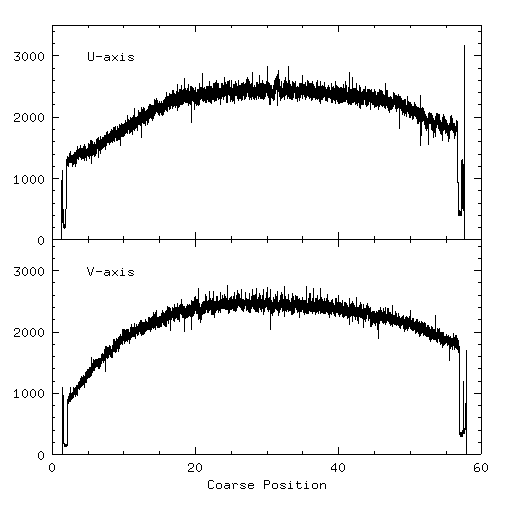
The resulting histograms show little evidence for residual gaps. This set of coefficients have been used by the ASCDS for all reprocessing of HRC-I XRCF data since August 1997. Expanded views of a few sections of the histograms, comparing the raw (undegapped) to the linear degapped data, are shown below (click on image to get full view).
These expanded views show how the gaps have, in general, been removed. However, these views also show that there are taps for which the distribution is not flat. In some cases, notably the V-axis projection from 25 - 35, the distribution peaks toward the center of each tap. This would be improved by adopting quadratic degap coefficients (see the corresponding projection image here). The projection for U-axis coarse positions 50 - 60 is more puzzling. The saw-tooth pattern along the distribution is almost certainly not due to variations in the illumination pattern and it is also difficult to understand why the detector efficiency would show such a pattern. Additional examination of the data reveal that the saw-tooth pattern is mainly produced by events with the highest pulse-heights. There is most likely some feature of the instrument electronics that is causing this systematic effect. A linear degap coefficient will not remove this systematic effect. A quadratic correction may be more successful. However, the corresponding quadratic projection still exhibits odd systematic behavior.
| U-axis | V-axis |
|---|---|
| 0-10 | 0-10 |
| 10-20 | 10-20 |
| 20-30 | 20-30 |
| 30-40 | 30-40 |
| 40-50 | 40-50 |
| 50-60 | 50-60 |
Details of the quadratic degap coefficients can be found
here.
Back to "Deriving HRC-I Degap for XRCF Settings (Flat Field Data)"
Back to "HRC Degapping Corrections"
Dr. Michael
Juda
Harvard-Smithsonian Center for Astrophysics
60 Garden Street, Mail Stop 70
Cambridge, MA 02138, USA
Ph.: (617) 495-7062
Fax: (617) 495-7356
E-mail:
mjuda@cfa.harvard.edu